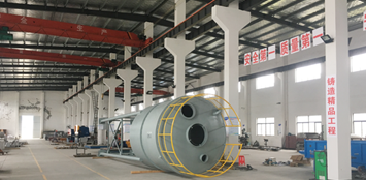To prevent the deformation and cracking of the die casting mold during heat treatment, die casting companies have a way
Release time:
2023-03-17 10:55
Die casting companies understand that in the production and processing of die casting mold parts, due to their complex shape and structure, there are obvious differences in the cross-sectional dimensions of each part, so the heating and cooling rates of each part are different during the heat treatment process. This situation can lead to different thermal stresses, microstructure stresses, and phase transition volumes in each part of the part. It causes abnormal expansion or contraction of the volume of the part, resulting in a large deviation in its size and shape, and even cracks.

Die casting companies say that there are many reasons for deformation and cracking of die casting molds during heat treatment, including the chemical composition and original structure of steel, the structural shape and cross-sectional size of parts, heat treatment process and other factors. In actual production, deformation cannot be completely eliminated, only to reduce the degree of occurrence as much as possible. However, cracking can be completely avoided as long as proper measures are taken.
Preparation for heat treatment
The so-called preliminary heat treatment is relative to the final heat treatment, that is, before the heat treatment, a preparatory heat treatment step is added, which can provide good processability or microstructure for the final heat treatment. Common preheat treatment processes include annealing, normalizing and quenching and tempering.
The die-casting company said that the preliminary heat treatment of the steel stamping die focuses on eliminating the mesh secondary cementite in the forging, refining the grain and internal stress. The specific process is first normalized treatment, and then spheroidized annealing. For stamping die parts, low-temperature tempering should be employed to stabilize them. For molds with complex shapes and high precision requirements, due to the greater possibility of deformation cracking during heat treatment, appropriate tempering treatment should be carried out after rough processing and before finishing to prepare for final heat treatment and avoid cracking as much as possible.
Parts quenching method and protection
Quenching and tempering are processes that have the potential to deform and crack parts. Used for some small die-casting molds, slender cylindrical parts or high alloy steel mold parts, etc. The quenching method of direct heating should be avoided. Instead, it should be preheated to 520-580 and then heated to quenching temperature in a medium-temperature salt bath. Practice has proved that the deformation of the parts heated by this method is significantly smaller than the deformation of the parts directly heated and quenched by electric furnace or reverberation furnace, and cracking can basically be avoided.
During quenching, if the heating temperature of austenitic parts is too high, the grains will be coarse, which will easily cause oxidation, decarburization and other phenomena, resulting in deformation and cracking of parts. However, if the temperature is too low, the inner hole of the part will shrink and the hole diameter will become smaller. Therefore, the upper limit of the quenching temperature should be selected within the allowable heating temperature range as much as possible. For alloy steel, if the heating temperature is too high, the inner hole will expand and the pore diameter will become larger, so it is good to choose the lower limit of the allowable temperature. In addition, in the quenching and tempering process, effective measures need to be taken to protect parts that are prone to deformation and cracking, so that the shape and section are symmetrical and the internal stress is balanced. Especially those parts with complex shapes. Common protection methods include bundling, padding and blocking.
Optimization of cooling methods and selection of coolants
The die-casting company reminds everyone that when the die-casting mold parts are heated, they should not be directly put into the coolant after the furnace, which is easy to cause excessive local temperature difference, resulting in deformation and cracking. The correct method is to pre-cool the part in air before quenching in coolant. In order to ensure that the cooling rate of each part of the part is uniform, proper rotation should be carried out after putting in the coolant, and the rotation direction is good and not fixed.
The choice of coolant is equally important. For alloy steels, thermoquenching or graded quenching with potassium nitrate and sodium nitrite hot bath is an effective way to reduce deformation, especially for die-casting molds with complex shapes and precise dimensions. Some porous mold parts have the characteristics of cooling shrinkage in oil and cooling expansion in nitrate. The rational use of two different media can also reduce the deformation of parts due to quenching.
Control of tempering treatment
The die-casting company said that after the die-casting parts are quenched in the coolant, they should not stay in the air for too long, but should be put into the tempering furnace in time to temper to eliminate the internal stress of the parts and reduce the tendency to deformation and cracking. Especially for some die-casting mold parts that require wire cutting, segmented quenching and repeated tempering heat treatment before online cutting can effectively improve the hardenability of parts, make the internal stress distribution uniform, and prevent deformation and cracking. In the tempering process, the occurrence of low-temperature tempering brittleness and high-temperature tempering brittleness should be avoided.
Die casting company
Related news
2019-09-02
Suzhou Yueerhan Machinery Technology Co., Ltd
In order to make the company more competitive, it invested 20 million yuan in 2010 and 5 million yuan in 2018 to add die-casting machines, X-ray flaw detection equipment, spectral analysis equipment and various product performance testing equipment, so that the quality of products can be effectively controlled. The company has passed ISO9001-2015 certification, in order to meet the needs of customers. Adhering to the enterprise tenet of "pursuing good quality and timely service", our company constantly promises and serves customers with perfect service and scientific management, and creates a better tomorrow with you!
2019-09-02
Suzhou Yueerhan Machinery Technology Co., Ltd
The company is located in the scenic Yangcheng Lake in Xiangcheng District, Suzhou, bordered by Shanghai-Nanjing Expressway in the north and Sujiahang Expressway in the east, with convenient transportation. Founded in 1993, the company is mainly engaged in the manufacturing, sales and service of drum washing machine bracket shaft, tripod, pulley, door hinge, door hook, cross, wind impeller, bearing seat, etc.
2019-09-24
Yueerhan machinery technology service tenet
Suzhou Yueerhan Machinery Technology Co., Ltd. was established in 1993, the company is located in the scenic Yangcheng Lake in Suzhou Xiangcheng District, north of Shanghai-Nanjing Expressway, east of Sujiahang Expressway, convenient transportation.
2019-09-24
China's GDP accounting reform is a contribution to the world
The three major international organizations praised China's GDP accounting reform as a contribution to the world
2019-09-24
Made in China from "usable" to "well-used" and "easy to use"
Consumers expect that after China's manufacturing has completed the upgrade from "usable" to "well-used", it can also achieve the upgrade from "well-used" to "easy-to-use", which puts forward higher requirements for supply-side services.
2019-09-24
Spend a good full moon and happy Mid-Autumn Festival
Spend a good full moon and happy Mid-Autumn Festival





